Olympus E-M5 Mark II Review: Weatherproof, Great Photos
Compact, powerful and weatherproof, the Olympus OM-D E-M5 Mark II lets you shoot great photos and videos nearly anywhere.
Why you can trust Tom's Guide

Olympus cameras inspire affection in many people because of the devices' petite, metal-clad designs; retro SLR looks; and colorful photos. The new OM-D E-M5 Mark II is no exception. Its weatherproof, black magnesium-alloy body feels reassuringly solid, and it's easy to carry anywhere. It also packs impressive goodies, like five-axis image stabilization, that make it one of the best mirrorless cameras, especially for video.
Design: Small enough to take anywhere
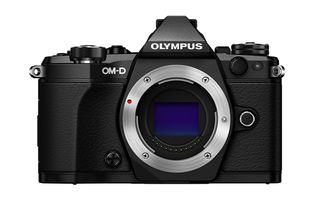
The E-M5 Mark II is a candid and street photographer's dream. Weighing just a pound for the body, plus 0.3 pounds for the 25mm lens I used, it was barely noticeable hanging from my shoulder. Even with the lens I used for testing — the $400, 1.6-inch M.Zuiko 25mm f1.8 (50mm equivalent) — I could fit the camera inside my winter coat. The E-M5 Mark II also has a fairly quiet mechanical shutter and the option to enable a silent electronic shutter for stealthy shots of animals, people or performances.
MORE: Best Mirrorless Cameras
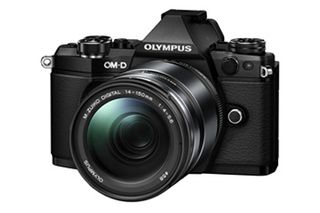
The E-M5 Mark II doesn't have a built-in flash, but Olympus includes a small flash that slips into the hotshoe atop the camera. This flash is not very powerful, but it does tilt up, so you can use bounce flash for softer lighting. Olympus sells more powerful external flashes separately.
(Olympus declined to reveal the resolution of the screens on the E-M5 Mark II, other than to provide an overall count of "dots," or subpixels. We reverse engineered the likely resolutions.)
The 3-inch, 720 x 480 LCD touch screen is massive for such a small camera. Its tap-to-focus capability is great for action shots when you can't trust the camera to know what to focus on. The screen swings out to the left and rotates 270 degrees for framing shots from just about any angle — including for a selfie. That's generally a good thing, but it makes the whole package bigger and harder to hold.
A 1024 x 760 LCD viewfinder will help DSLR switchers feel at home, although it has a more "digital" look than the lifelike OLED viewfinders in Sony, Fujifilm and some Samsung cameras.
Below is an example of the fleeting moments you can catch with the E-M5 Mark II thanks to its small size and quiet shutter. Using the rotating LCD screen, I could shoot while holding the camera in my lap.

You can click on any photo to bring up a larger version.
The E-M5 Mark II's controls feel solid, but they — and especially the on-screen menus — were a frequent annoyance. More on that below.
Autofocus and Speed: Pretty dependable
The E-M5 Mark II's image sensor uses old-style contrast-detection autofocus rather than the DSLR-grade phase detection found in Olympus' older, $1,400 OM-D E-M1 (see review) and even in cheaper rivals such as the $550 (body only) Sony a6000. So I was happy to see that in bright or medium lighting, this camera's 81 focusing sensors quickly locked on.
In lower light, such as a bar, I encountered occasional "hunting," with the lens moving back and forth to find its target. That's a classic weakness of contrast detection: Under low light, there's less contrast to detect.
MORE: Why Autofocus Is the New Megapixel

Burst shooting up to 10 fps was more than enough to ensure at least one good shot during action. Unlike cameras such as the 11 fps Sony a6000 (see review) with phase detection, the E-M5 Mark II can't refocus for each photo at its top burst speed. But it can for shorter 5 fps bursts, which was still plenty for the photo below of people walking toward me in the snow. The color is just about perfect, too.
Short of sports photography or capturing dimly lit streets and interiors, the E-M5 Mark II should be plenty fast, even for candid photography.
Image Stabilization: Remarkable in video
The E-M5 Mark II's five-axis image stabilization is phenomenal, especially for video. The sensor shifts to counteract five types of inadvertent motion: pitch (tilting up and down), yaw (turning side to side) and roll (rotating), as well as vertical shift (moving straight up or down) and horizontal shift (moving to the left or right). In video mode, the M5MII also provides digital image stabilization to further smooth out the jitters.
The camera has four image-stabilizing modes (plus the option to turn image stabilization off for using a tripod or saving battery). An Olympus representative told me that it's best to use the Auto I.S. mode for general shooting, and I did.

Here are still-image samples from about a dozen shots taken in a speeding subway train, at 1/30-second shutter speed, with stabilization on for some and off for others. Sometimes photos looked equally sharp regardless of settings. But in the worst cases, when the train was really rocking, the difference was clear, as in the comparison with Auto I.S. on, at left, and off, at right.
Click on the image to bring up a 100-percent-crop comparison.
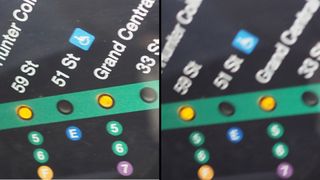
Video is where the five-axis stabilization really matters. To test the system, I shot many long clips walking with the camera, such as an eight-minute journey from the subway station to my office. Below is a one-minute excerpt. If you'd like to see the whole segment, head over to the Tom's Guide YouTube channel. It's not completely free of jitters, but I wouldn't be able to get anything so smooth with a typical camera, even using an image-stabilized lens, unless I put it on a steadycam rig several times the size of the camera. With its image-stabilization system, the E-M5 Mark II is as good for spontaneous movie-making, even action movies, as for candid photography.
The rival Sony a7 II full-frame, mirrorless camera also has five-axis stabilization, which worked very well in our review. I didn't have an a7 II on hand to compare the two cameras, but I believe this Olympus system is at least as good.
Image Quality: Very pleasing
Like other Olympus cameras we've tested, the E-M5 Mark II consistently captured attractive color. I also found the contrast and dynamic range to be very good. Pixel noise, or graininess, was tolerable up to ISO 6400, depending on the lighting. That's good for a camera in this price range, and enough to allow some nice low-light photography. The camera's sensitivity goes up to ISO 25,600 — four times greater light sensitivity — but the top ISO settings never look good on any camera.
The color accuracy is excellent in the Natural picture mode I used for most of my testing, which I found to be the best. This photo looking up Fifth Avenue is an honest portrayal of a pale winter day. The flags on the right did have the faded look you see in the photo. The sky looks about right, too.

The next photo shows the E-M5 Mark II at its best. This shot of houses in Bedford Stuyvesant on a cold, clear morning with direct, warm-colored sunlight was taken under optimal conditions: the camera's lowest ISO of 200, a fast shutter speed of 1/500 to eliminate camera shake and an F/9 aperture to provide some depth of field. The colors are gorgeous without being oversaturated. The highlights are bright without overexposure, and detail remains in all but the very darkest areas under the steps.

This photo from an exhibit at Lincoln Center contains a lot of info. Shot in Pattern Metering mode, which evaluates the whole frame equally, it shows respectable exposure. A spotlight trained on the glass sculpture is also shining on the woman. Only some of her hair and collar are overexposed, and just the bits of her coat that are in full shadow have gone totally black. The dimmer background is well-illuminated, too.

Shot at ISO 6400 sensitivity, the picture shows little noise. Viewed at 100 percent magnification (big enough for a poster), the woman's face is a little grainy but still presentable. Down around 75 percent or smaller (still huge), noise nearly disappears from the subject. That's impressive because Olympus uses the small, oddly named Micro Four-Thirds image sensor, which is about two-thirds the size of the APS-C sensor in most mirrorless and DSLR cameras and just a quarter the size of a full-frame sensor, as found in the Sony a7 II. Smaller sensors and pixels gather less light. Below is a 100 percent crop.

The white balance is great, with scarcely any of the warm (orangey) cast typical of any camera's indoor shots using auto white balance. Some people like that warm glow, and the E-M5 Mark II has options to please anyone. Deep in the camera's menus is a setting called WB Auto: Keep Warm Color. If you like the warm glow, leave it in the default On setting. If you want the most accurate color, turn it off. Below is an example of the difference. The photo on the left was shot with the feature on, the one at the right with it off.

The right-hand photo looks extremely good for auto white balance, and is more accurate. With other cameras, I would have to pick a preset mode such as Tungsten light or do a manual white balance to get that close. You can always add a bit of warmth with the color temperature control found in even the cheapest and free photo editing program. (See our recommendations.)
40-Megapixel Mode: A neat trick
The E-M5 Mark II's sensor contains 16 megapixels. But Olympus figured out a trick using the image stabilizing system to shift the sensor ever so slightly for a series of eight shots that make up a 40-MP photo. (The math is complex.)
MORE: How Many Megapixels Do You Really Need?
There are caveats, though. The camera has to be completely still, ideally mounted on a tripod, and nothing in the scene can move, so no portraits. This feature is best for a still life or for product photography, especially in a studio setting. And that's how we tested it, in the same studio where we shoot products, on a seamless white background, complete with strobes.

The composited 40-MP image has substantially more detail than the basic 16-MP photo. It also shows a bit more detail than a photo we took with a 22.2MP Canon 5D Mark II DSLR. That may seem like a given, based on the number of megapixels, but Canon's 5D cameras use full-frame sensors and are standard equipment for many studio photographers. The E-M5 Mark II more than held its own.

Pros probably won't be rushing out to get the E-M5 Mark II, though. They probably already have expensive collections of lenses for Canon, Nikon or some other brand that already provides very high-res options, such as the 36.3-MP Nikon D810 (see review) or Canon's upcoming pair of 50MP DSLRs.
Video Quality: Sharp with great Color and clear sound
As you saw above, the E-M5 Mark II keeps video steady and quickly snaps focus onto new subjects as they enter the frame. It does all that in low light, too, while maintaining accurate color balance (with the Keep Warm Color option turned off). In this 1.5-minute steadycam-style shot at an event space, I walked up and down steps, strolled around, panned across the room and even kept video rolling as I sat down.
The video also shows the E-M5 Mark II's continuous autofocus, in the same place where I encountered the hunting autofocus for still shots. In video, the camera took a few split seconds to figure out the right target, which is far better than jumping all around. The video is very sharp considering how often the camera had to refocus on something new. Rival cameras with phase-detection autofocus can shoot in even lower light. Videos (and photos) I tried to capture in a dim karaoke bar were mostly out of focus. When the camera did lock focus, it couldn't sustain it, and kept blurring. Given how common phase-detection has become, even in some budget mirrorless cameras, the failure to include it in the pricey E-M5 Mark II is a glaring oversight.
The built-in stereo mics captured solid audio, as you can hear in this trumpet and trombone duet on a subway platform. (Forgive the bad panning shot.) If you're shooting something that isn't so high volume, such as an interview or dialog for a movie, you should plug in a higher-quality external microphone.
This clip is also a good test of color and white balance, with varying skin tones and white tiles under fluorescent light.
Controls and Interface: Aggravating
Here's where things get ugly. The E-M5 Mark II has one of the worst interfaces I have seen, and its closest rivals are other Olympus cameras (followed by Fujifilm).

The physical controls look good. The front knob (encircling the shutter button) and rear knob are easy to reach for quick adjustments, such as Shutter and Aperture in Manual mode or Shutter and Exposure Compensation in Shutter Priority mode.
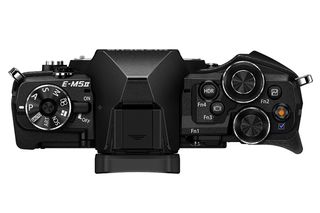
But the knobs spin too easily. I got dozens of shots that were under- or over-exposed because my finger brushed against the front exposure-compensation knob.
As a camera geek, I loved the five function buttons and the four-way rocker on the back, which can be reprogrammed to access a particular setting. But some of the settings I use the most are missing. None of the buttons can be set to bring up options for light metering (like matrix or center weighted), focus area (such as single point or whole frame), or autofocus mode (like manual, single or continuous).
MORE: DSLR vs. Mirrorless Cameras: Which Is Better for You?
You can get to a lot of, but not all, important settings by pressing the OK button on the back of the camera to launch an on-screen menu, optimistically called the Super Control Panel, with icons for items such as ISO, White Balance and, yes, light-metering and autofocus modes. But you won't find a focus area control, only a grid icon that lets you move a single focus point around the frame. Getting to that setting is just one example of how difficult the menus can be.
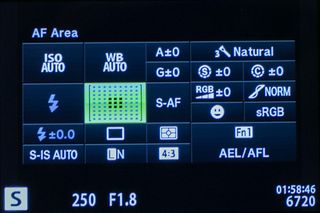
To change focus area, you have to: press the OK button to open the on-screen menu, scroll over to the focus grid icon, press OK again to bring up a grid of green squares on the screen, press the Info button on the back of the camera, and finally use the four-way rocker to select focus area as well as face- and smile-recognition options. With the Sony a7 II, all I had to do was press a shortcut button I had set up and use one of the control knobs to scroll through my autofocus area options.

Battery Life: Adequate
Olympus tests show that the stock E-M5 Mark II battery will last for 310 shots in default setting or 750 shots with Quick Sleep Mode enabled. (Both with image stabilization turned on.) Using Quick Sleep mode, I got a mere 413 photos. However, I also captured about five minutes of HD video at 60fps, and spent a lot time with the LCD while reviewing photos and evaluating menus. Still, 750 photos seems optimistic based on my experience.
As with nearly any mirrorless camera, you should buy a second battery to make it through a full day of shooting. A spare battery for the E-M5 Mark II costs $60.
Bottom Line
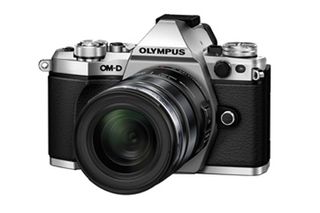
The E-M5 Mark II is one of the best cameras for candid shooting, and certainly the smallest, as long as the lighting is good. Autofocus is quick in most conditions; five-axis image stabilization keeps photos and especially videos steady as you move around, and the alloy body with weather sealing means this camera is ready for all conditions.
The camera's tiny size and negligible weight, especially with Olympus' smaller lenses, make lugging it around a nonissue. For candid photography, the E-M5 Mark II's size, rotating screen with tap-to-shoot and quiet shutter (with a silent option) are ideal for keeping a low profile.
Not to be forgotten, this camera's photos and videos are gorgeous, with accurate color, good exposure and acceptable noise at high ISO. The lack of phase-detection autofocus is a bummer, as it would complete the package for this candid shooter. Still, for all-around shooting, with constantly changing subjects and weather, the Olympus E-M5 Mark II is worth the price.
Sign up to get the BEST of Tom’s Guide direct to your inbox.
Upgrade your life with a daily dose of the biggest tech news, lifestyle hacks and our curated analysis. Be the first to know about cutting-edge gadgets and the hottest deals.
Sean Captain is a freelance technology and science writer, editor and photographer. At Tom's Guide, he has reviewed cameras, including most of Sony's Alpha A6000-series mirrorless cameras, as well as other photography-related content. He has also written for Fast Company, The New York Times, The Wall Street Journal, and Wired.
